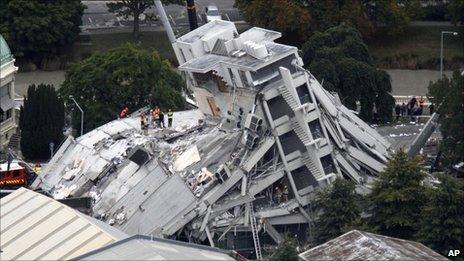New Zealand quake: Workers embark on delicate rescue
- Published

Several major office buildings in Christchurch were badly damaged
"Silence please," shouted a boiler-suited rescue worker, as he peered into the wrecked remains of the Pyne Gould Guinness building.
The modern office block was almost completely destroyed in Tuesday's earthquake and has now become the primary focus of the Christchurch rescue effort.
The team of firemen had heard the voice of a middle-aged woman, who had somehow survived the collapse of her workplace by crouching under a desk and staying there for 24 hours.
Fortunately, she could still muster the strength to cry out.
Now, the firemen had set about trying to pull her out, without bringing down the building on her and them.
It was painstaking and delicate work, with a ludicrously high degree of difficulty - the fear being that a false or hasty move could also be a deadly one.
Massive cranes were on hand to lift the fallen masonry, but the firemen preferred to work with small hand-tools, like hammers and chisels.
'Crush of concrete'
Big, burly firemen approached the task with enormous precision - tip-toeing through the rubble and climbing up the rescue ladders as lightly as they could.

Dozens of people have been rescued alive from the wreckage
They did not want to disturb this concrete house of cards.
The woman was said to be in remarkably good spirits - it was now almost 24 hours since the quake hit - and to provide her with physical sustenance, they attached a water bottle to a rod and tried to poke it through the rubble.
But so tight was the crush of concrete and masonry that the bottle of water was too big to push through the small fissures.
Her husband looked on helplessly, totally reliant on the professionalism of the rescue crews and hoping perhaps that the aftershocks that shake this city every couple of hours or so would hold off.
Sixty minutes later - after 25 hours trapped in the rubble - Ann Bodkin was brought out wrapped in a brown blanket, very much alive.
From the firemen who rescued her, there was a small ripple of applause.
A rare moment of muted celebration in the midst of so much bereavement.
'Continued danger'
The Mayor of Christchurch, Bob Parker, had watched the rescue unfold.
"The sun came out the moment she was removed from the building," he said. "It was like God turned on the lights."
Over at the Canterbury Television building, another wreck, darkness prevailed.
The building was in such a ruinous state that rescue workers deemed it unsurvivable.
Their heat-seeking cameras and listening devices could not detect any sign of life.
It is feared that dozens could be buried beneath the rubble, and if the death toll rises over the coming days then the CTV building will probably be the main reason why.
Sporadic aftershocks are complicating the rescue effort, and today I watched as rescue workers were told to evacuate part of central Christchurch because of the fear that its tallest building, the Grand Chancellor Hotel, was about to collapse.
Certainly, it was listing badly and its structure was clearly unsound.
This is definitely a city with continued danger, and, I fear, mounting death.
- Published25 February 2011
- Published23 February 2011
- Published22 February 2011